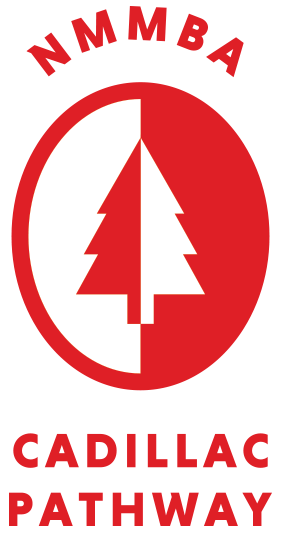Thirty-five years ago I first skied the newly created Cadillac Pathway, an 11 ½ mile trail system, that was developed by the DNR under the direction of Del Wieland. This was a vast improvement over the bushwhack make-your-own path ski trips we’d been doing. Not only did we now have a defined path marked with signs to follow, but it was groomed. Once a week, usually on Fridays, so weekend skiers would have a good trail, Harold Kibbe from the DNR would drive a snowmobile dragging a two-runner sled over the Pathway.
The Pathway, by being so close to town, became popular with those looking for good exercise after work. On weekends the parking lots on both ends, near the Seeley Rd/Boon Road intersection and, at the southern entrance off Crosby Road, were filled with skiers’ cars.
Then in 1986 the Michigan Department of Transportation was allocated funding to build a bypass so US 131 wouldn’t have to pass through downtown Cadillac, however, the new construction was slated to cut through the land occupied by the Cadillac Pathway. For the skiers this was distressing news. Roger Wotila, a local attorney, researched federal regulations and discovered a ruling made in Georgia which said a federal project could be prevented from passing through a recreational area. Because the Cadillac Pathway was located in the Pere Marquette National Forest, and had been developed as a recreational area, it seemed appropriate to apply the court ruling made in Georgia to the Pathway. “After that,” Wotila recalled, “Representative Ouwinga and MDOT worked to preserve that area and put the highway in a different place.”
Another challenge came in 2005, when DNR budget cuts eliminated the funding for trail grooming. To deal with this, Roger Hopkins, an avid skier, noted that, “Then DNR Supervisor Bill Sterrett met with Jim (Neff), Jerry (Nilsson), myself, and representatives of the Wexford Missaukee Career Tech Center (WTC) to create a three-party (DNR, WTC, and Friends) partnership to groom and maintain the Cadillac Pathway.”
To get the program going, the DNR donated a snowmobile. A groomer was designed and built by the Fabrication Class from the Career Tech Center, taught by Darin Kearns and Dave Mackey’s power sports class took over the maintenance of the snowmobile and groomer.
Hopkins and Nilsson, along with other volunteers, began grooming the trail for cross-country skiers. When snow conditions permit, the grooming crew tries to get out at least once a week. Hopkins observed, “If everything goes right we can groom thirteen miles of trail in about two hours.”
According to outdoor writer Jim Dufresne, The Cadillac Pathway is the southernmost groomed state pathway in Michigan.” Dufresne attributes this to the ski trail being located in a hilly region where the Pathway tops 1400 feet elevation five times and features a stretch from Seeley Road to Signpost 8 where the trail climbs 130 feet. The higher elevation may be helpful in keeping snow on the ground, but its ups and downs creates challenges for skiers.
The hillier section begins begins almost immediately. Skiers leaving the parking lot just off Crosby Road adjacent to the Wexford-Missaukee Intermediate School Building have two choices as they begin and both of them are uphill. These are easy climbs, but if you’re over-dressed the sweat will begin to flow. A mile into the route, after a looping s-shaped descent, the trail reaches a junction. Go right and you’re on a 2.25 mile rolling loop back to the parking lot; go left and you’re on a 4.9 mile circuit which includes the steepest hills of the Pathway and the only section marked as black diamond. As you head into the last half-mile before Milepost 8, there’s a a bypass which allows you to skip the the sharpest drop of the entire route. Known by locals as the”Big Kahuna,” this hill is not for novice skiers and only the pros want to mess with it when it’s icy.
Milepost 8 is the turnaround point for those wanting to settle for just a half-loop. Coming from the other start point, the parking lot off Boon Road, the terrain is more level and includes three crossover loops of 1.3, 2, and 3.5 miles. The toughest hill shows up on the return of the 5.2 mile circuit just after crossing Seeley Road. Fortunately, climbing it is an option, as there is a well-used bypass circumventing this climb.
The Cadillac Pathway is our hometown ski trail. On a weekend afternoon when the snow is good and weather is accommodating, I’ll always see folks I know from town. Some are skiing fast, perhaps training for the VASA or White Pine ski races, but most are moving easily on gentle diagonal strides. Often these appear to be family outings, with parents helping teach the next generation the basics of cross country skiing. As I come up behind these families on skis, I’ll remember back, a quarter century ago when Cyndy and I were teaching our kids how to move forward on skinny skis. I am grateful that back in the late 1970s a group of local skiers and DNR personnel had the vision and put forth the effort to create the Cadillac Pathway.

Thanks for the history lesson Dave. I remember many fine outings in the late seventies and especially the early eighties pumping through the trails at the Cadillac Pathway. I still ski there occasionally, but not as often as I used to. For many years dog ownership kept me (mostly) off the Cadillac Pathway and took me other places that weren’t groomed, and thus a pair of back country skis. But I’ve always considered it one of the best X-country ski trails in the state. We are fortunate that some folks had the foresight and determination to make it a reality forty-some years ago. And I’m appreciative of those who have stepped up to groom it and take it to the next stage with the Winter Sports Trail.